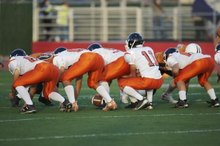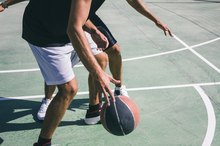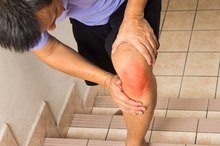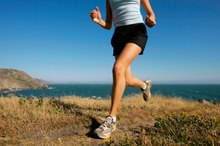Pain Above the Knee Cap With Running
Chondromalacia patellae refers to a dull pain in the area of the knee cap. Many athletes, especially runners and cyclists, suffer from the syndrome. Determine the cause of the pain in your knee to get the appropriate treatment and and take steps to prevent future knee pain and injury.
Causes
The knee is the largest joint in the body and experiences stress every day, especially when you run. As your feet hit the ground, your knee serves as a shock absorber. Because the joint relies heavily on tendons, ligaments and muscle -- all soft tissues -- the repetitive stress can lead to pain. Many young runners, especially females, have knee caps that do not line up well with the rest of the leg, and this misalignment is a common cause of chondromalacia.
- The knee is the largest joint in the body and experiences stress every day, especially when you run.
- Many young runners, especially females, have knee caps that do not line up well with the rest of the leg, and this misalignment is a common cause of chondromalacia.
When to See a Doctor
Knee Pain From Kicking a Ball
Learn More
Pain around the knee cap may also indicate other more serious conditions, such as arthritis, so see your doctor to diagnose the cause of your pain. Common symptoms of chondromalacia include a dull pain that worsens after prolonged sitting, a grinding sensation as you straighten and bend your knee, and tenderness when you push on the knee cap with your leg straight. If you experience sudden pain, inability to put weight on the knee or a popping sound, see your doctor right away, as these symptoms could indicate a tear in one of the joint's tendons or ligaments.
Treatment
To temporarily relieve knee pain from running, your doctor may prescribe rest and over-the-counter nonsteroidal anti-inflammatory drugs, like ibuprofen or aspirin. If the pain is severe or persistent, a physical therapist can help evaluate your leg alignment and suggest exercises to help correct your posture and running stride. If other treatment options don't work, arthroscopic surgery may help.
Prevention
How to Treat Shin Splints
Learn More
One of the best ways to prevent knee pain and injury is to strengthen the hamstrings and quadriceps muscles, which lend support to your knee joint. Squats, lunges and leg presses work both muscles at the same time, while leg extensions isolate your quadriceps and lying leg curls isolate your hamstrings. When you run, always wear supportive shoes, and replace shoes before they become worn out. Repetitive movements can lead to pain, so consider alternating your workouts between running and other activities, such as biking or swimming.
- One of the best ways to prevent knee pain and injury is to strengthen the hamstrings and quadriceps muscles, which lend support to your knee joint.
Related Articles
References
- University of Maryland Medical Center: Anterior Knee Pain
- University Orthopaedic Center: Chondromalacia of the Patella
- Lespasio MJ, Piuzzi NS, Husni ME, Muschler GF, Guarino A, Mont MA. Knee Osteoarthritis: A Primer. Perm J. 2017;21:16-183. doi:10.7812/TPP/16-183
- Kiapour AM, Murray MM. Basic science of anterior cruciate ligament injury and repair. Bone Joint Res. 2014;3(2):20-31. doi:10.1302/2046-3758.32.2000241
- Doral MN, Bilge O, Huri G, Turhan E, Verdonk R. Modern treatment of meniscal tears. EFORT Open Rev. 2018;3(5):260-268. doi:10.1302/2058-5241.3.170067
- Reinking MF. CURRENT CONCEPTS IN THE TREATMENT OF PATELLAR TENDINOPATHY. Int J Sports Phys Ther. 2016;11(6):854-866.
- Petersen W, Rembitzki I, Liebau C. Patellofemoral pain in athletes. Open Access J Sports Med. 2017;8:143-154. doi:10.2147/OAJSM.S133406
- Frush TJ, Noyes FR. Baker's Cyst: Diagnostic and Surgical Considerations. Sports Health. 2015;7(4):359-65. doi:10.1177/1941738113520130
- Huang YC, Yeh WL. Endoscopic treatment of prepatellar bursitis. Int Orthop. 2011;35(3):355-8. doi:10.1007/s00264-010-1033-5
- Beals C, Flanigan D. A Review of Treatments for Iliotibial Band Syndrome in the Athletic Population. J Sports Med (Hindawi Publ Corp). 2013;2013:367169. doi:10.1155/2013/367169
- Tsai CH, Hsu CJ, Hung CH, Hsu HC. Primary traumatic patellar dislocation. J Orthop Surg Res. 2012;7:21. doi:10.1186/1749-799X-7-21
- Ragab G, Elshahaly M, Bardin T. Gout: An old disease in new perspective - A review. J Adv Res. 2017;8(5):495-511. doi:10.1016/j.jare.2017.04.008
- Lee PYF, Nixion A, Chandratreya A, Murray JM. Synovial Plica Syndrome of the Knee: A Commonly Overlooked Cause of Anterior Knee Pain. Surg J (N Y). 2017;3(1):e9-e16. doi:10.1055/s-0037-1598047
- Vaishya R, Azizi AT, Agarwal AK, Vijay V. Apophysitis of the Tibial Tuberosity (Osgood-Schlatter Disease): A Review. Cureus. 2016;8(9):e780. doi:10.7759/cureus.780
- Zanon G, Di vico G, Marullo M. Osteochondritis dissecans of the knee. Joints. 2014;2(1):29-36.
- Hindle P, Davidson E, Biant LC. Septic arthritis of the knee: the use and effect of antibiotics prior to diagnostic aspiration. Ann R Coll Surg Engl. 2012;94(5):351-5. doi:10.1308/003588412X13171221591015
- Gwinner C, Märdian S, Schwabe P, Schaser KD, Krapohl BD, Jung TM. Current concepts review: Fractures of the patella. GMS Interdiscip Plast Reconstr Surg DGPW. 2016;5:Doc01. doi:10.3205/iprs000080
- Voskuil R, Evenski AJ, Montgomery C, Emory CL. Malignant Bone Tumors of the Knee: How to Identify and Treat. J Knee Surg. 2019;32(4):305-314. doi:10.1055/s-0038-1675828
- Gupte C, St mart JP. The acute swollen knee: diagnosis and management. J R Soc Med. 2013;106(7):259-68. doi:10.1177/0141076813482831
- American Academy of Orthopedic Surgeons. Unstable Kneecap.
- Bhatia D, Bejarano T, Novo M. Current interventions in the management of knee osteoarthritis. Journal of Pharmacy & Bioallied Sciences 2013 Jan-Mar;5(1):30-38. doi:%2010.4103/0975-7406.106561
- Bronstein RD, Schaffer JC. Physical Examination of the Knee: Meniscus, Cartilage, and Patellofemoral Conditions. J Am Acad Orthop Surg. 2017 May;25(5):365-374.
- Browne K, Kurtz CA. How to perform a comprehensive examination of the knee. JAAPA. 2009 Jun;22(6):20-25.
- Hergenroeder AC, Harvey BS. (2017). Osteochondritis dissecans (OCD): Clinical manifestations and diagnosis. Bachur RG, ed. UpToDate. Waltham, MA: UpToDate Inc.
Writer Bio
Lydia Stephens began writing professionally in 2009. She has written online for Nile Guides, SheKnows.com and various other websites and has been published in "Stringing Magazine" and "Xiamen Wave." Stephens played competitive soccer for 19 years, has been weight lifting since 2007 and enjoys running, biking and sailing. She has a Bachelor of Arts in philosophy from the University of Texas.









